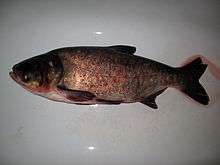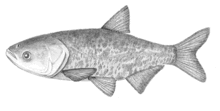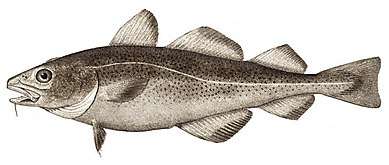Bighead carp
The bighead carp (Hypophthalmichthys nobilis) is a species of freshwater fish, one of several Asian carps. It is one of the most intensively exploited fishes in aquaculture, with an annual worldwide production of over three million tonnes in 2013, principally from China.[2]
| Bighead carp | |
|---|---|
 | |
| Scientific classification | |
| Kingdom: | Animalia |
| Phylum: | Chordata |
| Class: | Actinopterygii |
| Order: | Cypriniformes |
| Family: | Cyprinidae |
| Subfamily: | Xenocyprinae |
| Genus: | Hypophthalmichthys |
| Species: | H. nobilis |
| Binomial name | |
| Hypophthalmichthys nobilis (J. Richardson, 1845) | |
| Synonyms | |
| |
The bighead carp has a large, scaleless head, a large mouth, and eyes located very low on the head. Adults usually have a mottled silver-gray coloration. It is a large fish; a typical length is 60 cm (2 ft), and maximum observed size of 146 cm (4 ft 9 in) and 40 kg (88 lb).[3]
Bighead carp are native to the large rivers and associated floodplain lakes of eastern Asia. Their range extends from southern China north to the Amur River system, which forms the border between China and Russia.[4] They have been introduced widely outside their native range, including the United States, and they are considered invasive[3], as they out-compete native species (e.g. Bigmouth Buffalo).[5]
The bighead carp has a very fast growth rate, which makes it a lucrative aquaculture fish. Unlike the common carp, bighead carp are primarily filter feeders. They preferentially consume zooplankton, but also phytoplankton and detritus.
Aquaculture
The bighead carp is an important species in aquaculture, having the fifth-highest production (7.5%) of all cultured freshwater fish worldwide.[2] Its production grew from just 15,306 tonnes in 1950 to 3,059,555 tonnes in 2013, most of the growth being in China.[2]
Invasion
The value of bighead carp as a food fish has caused it to be exported from its native China to more than 70 other countries, where it has invariably escaped or been intentionally released to the wild. Today, the bighead carp can be found in the wild in Europe, South America, and North America. It also has been introduced into most of the Indian subcontinent (India, Pakistan, and most Southeast Asian countries) and to lakes in western China to which it is not native. Bighead carp are not always considered undesirable, invasive species where they are introduced outside their native range, and they continue to be stocked in some water bodies to support commercial fisheries. Stocking bighead carp or silver carp usually increases the total biomass of fish available for harvest, but can decrease the catch of native and sometimes more valuable fish.[4]
Bighead carp are considered a highly destructive invasive species in the United States. Bighead carp and the closely related silver carp (H. molitrix) were imported to the United States to remove excess or undesirable plankton, thus improve water quality in sewage treatment plants and aquaculture facilities. However, some fish escaped into the Mississippi River basin, where they are now firmly established. A national plan for the control of Asian carps, including bighead carp, was finalized in late 2007.
In the United States, a limited market has developed for bighead carp, particularly in ethnic communities, and they are farmed in ponds for this purpose. The live or very freshly killed market is most lucrative. Because of this, bighead carp are often transported live, and may be a high risk factor for the eventual spread of the fish, either through release by the end purchaser, or through escape during transport. Another potential avenue for unintentional spread of bighead carp is through use as fishing bait.[4]
Communities are attempting to contain the spread of the extremely invasive bighead carp. New York has banned the import and possession of live bighead carp, with the exception of New York City, where they still may be legally sold in live food markets (but they must be killed before they leave the premises). Possession of live bighead carp has been illegal in Illinois since 2005. Since February 2007, using LIVE bighead carp as fishing bait has been illegal in Missouri. In December 2010, the U.S. Congress banned the importation of bighead carp.[6]
Live bighead carp are also banned from sale in Canada. Several Greater Toronto Area Asian supermarkets have been fined in the past for selling them.[7] The Ontario Ministry of Natural Resources banned the live sale and importation into Ontario in 2004. Fines are only CAD$3500.00 and have done little to deter the possession of this fish; underground selling continues to happen in several Chinese supermarkets in the region. One live carp was found in Toronto's Don River in 2003.[8]
Killed carp can still be sold in stores, but Asian retailers and consumers prefer live over killed fish. Killed carp is cut into pieces: head, fillet, and tail.
Meat
North America

Although the bighead carp is enjoyed in many parts of the world, it has not become a popular food fish in North America. Acceptance there has been hindered in part by the name "carp", thus popular association with the common carp, which is not a generally favored foodfish in North America. The flesh of the bighead carp is white and firm, and not similar to that of the common carp, which is darker and richer. Bighead carp flesh does share one unfortunate similarity with common carp flesh - both have intramuscular bones within the filet. However, bighead carp captured from the wild in the United States tend to be much larger than common carp, so the intramuscular bones are also larger and less problematic. The Louisiana State University Agricultural Research and Extension Center has a series of videos showing how to prepare the fish and deal with these bones.
Singapore
In Singapore, it is known by the Chinese name 松鱼 (sōng yú).[9] The head of the bighead carp is particularly prized in Singapore, and is usually steamed whole.
Sport
Although bighead carp reach large size, they are difficult to capture with a rod and reel because of their filter-feeding habits. They may be captured by the "suspension method" used to catch silver carp, or where legal, by snagging them by jerking a weighted treble hook through the water. Bighead carp cannot be shot from the air like silver carp, because, unlike the silver carp, they do not jump from the water in response to moving boats. However, they often feed near the surface, where they can be shot by bowfishers, for whom they are popular targets.
References
- Huckstorf, V. (2012). "Hypophthalmichthys nobilis". The IUCN Red List of Threatened Species. 2012: e.T166172A1116524. doi:10.2305/IUCN.UK.2012-1.RLTS.T166172A1116524.en.
- "FAO Fisheries & Aquaculture Hypophthalmichthys nobilis". www.fao.org. Retrieved 7 March 2018.
- Froese, Rainer and Pauly, Daniel, eds. (2005). "Hypophthalmichthys nobilis" in FishBase. November 2005 version.
- "Kolar et al. 2005. Asian Carps of the Genus Hypophthalmichthys (Pisces, Cyprinidae) ― A Biological Synopsis and Environmental Risk Assessment" (PDF). Retrieved 7 March 2018.
- Lackmann, Alec R.; Andrews, Allen H.; Butler, Malcolm G.; Bielak-Lackmann, Ewelina S.; Clark, Mark E. (23 May 2019). "Bigmouth Buffalo Ictiobus cyprinellus sets freshwater teleost record as improved age analysis reveals centenarian longevity". Communications Biology. 2 (1). doi:10.1038/s42003-019-0452-0. ISSN 2399-3642. PMID 31149641.
- 18 USCS § 42
- Hui, Ann (16 January 2010). "Invasion of the bighead carp has Ontario scared". Retrieved 7 March 2018 – via Toronto Star.
- "Toronto Breaking News - Toronto's Online Newspaper - Toronto.com". Toronto.com. Retrieved 7 March 2018.
- "Kosher Fish For Consumers". The Torah Truth-Seekers and Messianic Goodnews. The Torah Truth-Seekers and Messianic Goodnews. Retrieved 2 April 2014.
- "Hypophthalmichthys nobilis". Integrated Taxonomic Information System. Retrieved 11 March 2006.
External links
- Species Profile - Bighead Carp (Hypophthalmichthys nobilis), National Invasive Species Information Center, United States National Agricultural Library. Lists general information and resources for Bighead carp.
- Facts About Invasive Bighead and Silver Carps, United States Geological Survey
- Great Lakes Fishery Commission
- Asian Carps of the Genus Hypophthalmichthys (Pisces, Cyprinidae) ― A Biological Synopsis and Environmental Risk Assessment



.png)
